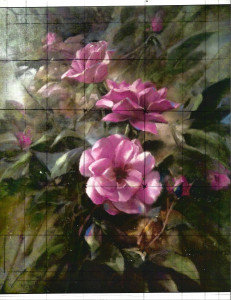Part 2 ~ Using the Golden Mean in Compositions
The post, “Composition, Part 1,” was about the importance of creating a strong composition using the Golden Mean and how to place and draw the lines of the Mean on the canvas before beginning to sketch. In “Composition, Part 2,” placing the primary and secondary focal points and directional lines using the Golden Mean is explored. Artists who know about and use the lines of the Golden Mean to place focal points and create dynamic movement in their paintings are able to subtly excite the viewer’s interest and entice them to come enjoy the highlights, motion and message of their paintings. This can ultimately result in a potential buyer’s appreciation of their artwork, and hence a sale.
This picture illustrates the Lines of the Mean superimposed over a painting of roses to demonstrate where the lines intersect in 4 quadrants (marked by dots) to create a scaffolding for Golden Mean composition. These intersections are prime locations to place focal points of light. Also, it illustrates how, by placing additional focal areas and “eye-magnets” on horizontal and vertical lines, moving from the center outward and diminishing in distance as they reach the edges of the canvas, a comfortable feeling of balance and movement throughout the composition will result.
The dominant central focal point in the painting is the edge of the larger rose in the lower right quadrant of the Golden Mean. This focal point catches the viewer’s eye at first glance and invites the viewer to notice the effects of light on the rose more than just seeing the rose as an object. If the light is effectively placed on the Mean, the viewer will come back to that special spot over and over because it is the most natural location for their eyes to rest. This is the objective of Golden Mean composition.
The viewer’s attention will increase if one or two additional focal points are included on the lines of the Mean. The placement and intensity of the second and third focal points should be less prominent than the primary focal point, and the three focal points are best seen when they are organized as a triangle with all focal points placed on lines of the Golden Mean. Placing them in a triangular formation allows the viewer to move from the strongest focal point to the second and third focal point, which creates a circular movement which cycles the viewer’s attention throughout the painting.
Another way to create movement and interest within the painting using Golden Mean composition is to create eye-catching lines that guide the viewer’s eye in and around the painting, and from one focal point to other focal points. Throughout human history, our eyes have kept us alive and safe from harm by scanning and moving from place to place, focusing and refocusing on points of interest or potential danger. This is the natural way we see. A strong composition uses “eye magnets” or objects and effects that guide the viewer’s eyes from the secondary focal points back to the main focal point. The lines that lead our eyes can be created by adding lines, brushstrokes, shapes that are part of the scene, and color patterns that establish direction, rhythm and unity throughout the composition. All of these directional additions are even more effective if placed on the lines of the Golden Mean.
When artists first apply the principles of Golden Mean composition to their artwork, they often find that this equation / tool that the early Masters used presents its own challenges and learning curve. It can be very frustrating, difficult, and time-consuming for artists who are unfamiliar with calculating equations and drawing lines on their canvas; then they have to deliberately use these lines to place their focal points, directional lines to create movement in their painting. With practice, patience and hard work, the Golden Mean will become a constructive and predictable tool to view and utilize the space on the canvas in ways that create a great composition.
For over 30 years, I have practiced and developed many techniques and tools that reveal the secrets of creating good paintings. Extraordinary artists continue learning new aspects of art while perpetually applying what they learn as they paint. There is nothing about being an artist that is easy. If you want it “easy,” you may be able to win a gold medal in a diving competition by performing a cannon ball dive from a low diving board into a shallow pool which would be the easiest level that an artist can aspire; or you can work hard to perform a perfect swan dive from a high diving board into a deep pool by learning to use the Golden Mean and achieve exceptional results painting great compositions.
___________________________________________
Plein air and Alla Prima artist Stefan Baumann, host of the PBS painting series “The Grand View, America’s National Park through the eyes of an artist” and author of “Observations Of Art and Nature,” travels in his vintage travel trailer painting America’s western landscape. Baumann paints outdoors with oils and canvas capturing stunning vistas, wildlife, western landscapes, National Parks and still life, thrilling art collectors throughout the world. He has many collectors acquiring his paintings as investment internationally. His painting style is called Romantic Realism with Lumunism and the extraordinary way he captures the effect of light is a truly an American Style used to paint the Western Landscape. He can be seen painting in Yellowstone, Yosemite and in the Grand Canyon and Baumann’s “how to paint” DVDs filmed on location in the National Parks are the very best on the market.


